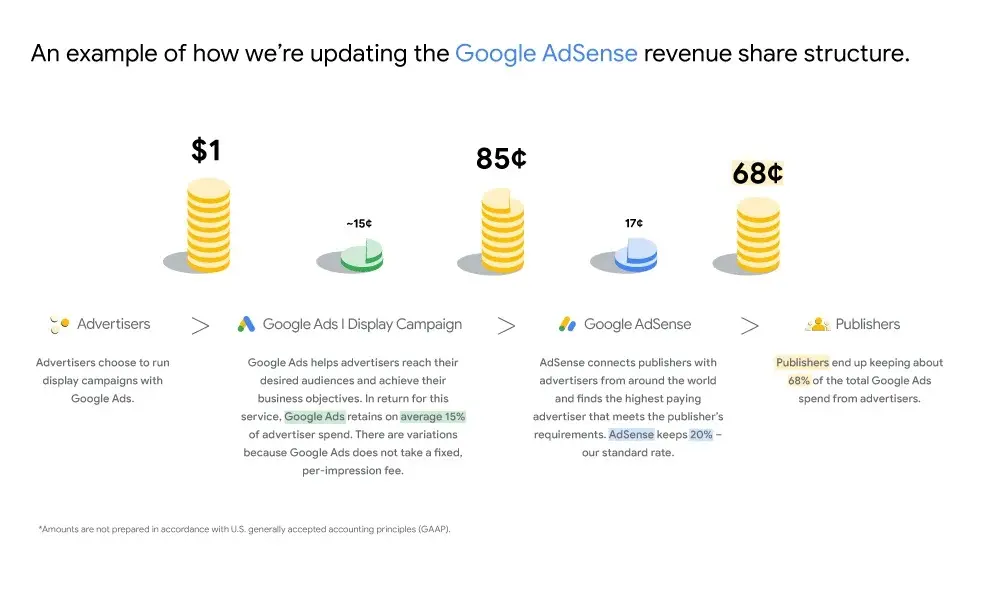Google AdSense has more than 2 million publishers in its network. The AdSense network is a suitable platform for publishers as it takes continuous efforts to make the platform more convenient for them to monetize their websites.
In that sense, recently, AdSense announced two important updates: a change in the revenue share structure and its transition from CPC to CPM model.
What exactly are these updates? Why did AdSense change it? And does it impact the publisher’s revenue? This blog has answers to all of it.
Table of Contents
New Google AdSense Updates for Publishers
Update in Revenue Share Model
Google AdSense’s previous revenue share model processes the fees within a single transaction where publishers get 68% of the total revenue for display ads and 51% for search ads with AdSense for search.
But now, in the newly updated revenue share model, AdSense will split* the revenue share into separate rates for the buy-side and sell-side.
In the new revenue share model, the publisher will get 80% of the revenue for displaying ads with AdSense after the buy-side takes their cut, either it be Google or third-party platforms.
*This initiative does NOT apply to AdSense for Search.
Case 1: When an advertiser puts ads on your website through Google Ads
Google ads will take its 15% cut on average. The share is not fixed; it might vary because most advertisers now pay depending on the user actions, clicks, and conversions. The publisher can keep their regular income 68% of the total revenue.
Case 2: When an advertiser puts ads on your website through a third-party platform.
The publishers will get 80% of the revenue after the third-party platform retains its share. In this transaction, Google will not have control nor visibility into how much the third-party platform charges the advertiser or how they estimate it.

Transition From CPC to CPM
The second update of Google AdSense is that it is moving from CPC to the CPM model to maintain consistency in the paying model and transparency in the media-buying process.
But before going into the details of why it changed CPC to CPM and whether it is any good for publishers, let us see what both terms are:
What is CPC?
CPC is a Cost-per-click revenue metric where publishers get paid on the number of clicks the ad receives. For instance, for the $1 CPC, the publisher will get $1 for one click and $10 for ten clicks.
What is CPM?
CPM is the Cost-per-thousand impressions metric where publishers get paid for a thousand impressions received by the ads. CPM is widely used in the current adtech ecosystem. For instance, for a $3 CPM, the publishers get $3 for every 1000 impressions the ads receive.
Is the transition from CPC to CPM good for publishers?
Moving to a per-impression basis is beneficial for publishers working on an impression basis, not a click basis.
A few of the crucial benefits include:
Lucrative options: CPM is lucrative because publishers get money based on impressions, not clicks. It is a suitable option for websites with high traffic as they can give a high impression to the ads they display.
Gets more demand: When publishers use CPM, they will get bids from advertisers who want high brand visibility for their products. In this case, CPM works great with high ROI.
Even advertisers who have just started to explore their CTR rates will use CPM because they can learn and change the loopholes in landing pages, CTA, page design, color, and messages that work great for their campaign with the clicks they get from CPM ads.
Overall, publishers get more demand and high ad revenue.
Reason for AdSense Moving From CPC to CPM
The AdSense moves from CPC to CPM because they want:
- Consistency in calculating ad revenue for publishers
- Since publishers use various platforms like ad exchange, programmatic means, and header bidding, CPM will make it easy to compare revenue across technologies. The change is also the reason that the CPM is widely used.
- It also improves transparency in media buying methods.
Does the Update Impact Publisher Revenue?
Google says that the change will not impact publisher revenue in any way. However, the comments in the social forums conclude that they can see whether the change impacts revenue only after it has been made live.
However, to be honest, publishers generating higher revenue from the CPC model might experience a dip. CPC is always higher than CPM. So, if a publisher having a good CTR, it would end up generating more revenue from their inventories. A shift to CPM might show an impact on their total revenue.
Google assures that the change will not influence the type or count of ads the publisher displays on the website. This means publishers can’t plaster ads all over the website, and maintaining good UX is very important. Thoughtful ad placement is necessary from the publisher’s side to benefit all the parties involved, including the advertiser and the intermediate platform.
Google AdSense wants publishers to adhere to AdSense policies and Better Ads Standards that don’t allow ads occupying full screen like pop-ups or interruptive ads.
Does It Affect Advertisers?
The update will not change anything on the buying model of advertisers. They can continue to bid and pay based on impressions and clicks.
Google will cover the correct fees in the transition from CPC to CPM.
When the Update Is Going Live?
The update on the revenue share model and CPM is to be rolled out in early 2024, and to adopt these changes, publishers don’t need to do anything other than track their earnings.
Demanding Simplification and Transparency
Since adtech is evolving rapidly day by day, it demands simplification, consistency, and transparency in whatever it does. AdSense released these updates to quench the demand.
Google made these strategic adjustments to streamline the media buying and selling process with high transparency in earnings. Thereby, it boosts financial health and independence in the publishing ecosystem.






















